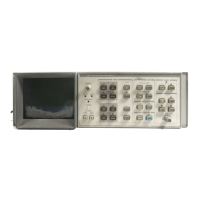maximum. Typically it takes about -40 to -50 V correction from minimum to maximum
brightness.
Focus also needs to be “fine tuned” from the front panel. The front panel control is a 25K
pot with the two ends tied to +15 V and -15 V with the wiper brought to the A1A2 Front
Panel Focus ©. The front panel signal is fed to an amplifier formed by U401A, R413 and
R415.
C412 compensates the amplifier for less than unity gain by creating a poll at 28 Hz.
C411 provides a passive filter on the input line. This was found to be necessary due to signal
pickup from the focus gate output signal by the PC trace between R413 and the input of
TJ401A that caused instability. R416 translates the approximately f7.5 volt output of U401A
into a current at the summing node of ±3.5 mA as the front panel focus knob is rotated from
one extreme to the other. This translates to a focus voltage range of ±40 V. Nominally the
instrument focus is set up such that the front panel knob is in the center of its rotation and
therefore is not producing any net current into the summing node.
The other two terms in the focus voltage correction signal are the top/bottom and the
right/left focus corrections. The CRT has significant curvature of the focus plane. As the
beam is deflected away from the center of the CRT, the focus voltage needed to give optimum
focus becomes more positive. Typically it requires 20 V at the right and left edges and 10
V at the top and bottom to give the best overall focus. Top k Bottom Focus © and Right
k Left Focus © contain identical offset absolute-value circuits. Since these two circuits are
identical, only the Top k Bottom Focus © is described.
The concept of this circuit is to generate a voltage that is proportional to the distance from
the center of the screen. Ideally, a parabolic function is desired. A three part piecewise linear
approximation will be adequate as the actual focus voltage requirements are not extremely
critical. What this circuit actually produces is a truncated, inverted “vee” current at the
input of the focus amplifier.
R425 and R427 provide a reference voltage for the offset of the absolute value. Normally R427
is set to give a one volt reference. This is nominally the video voltage that represents center
screen (0 V = bottom, 2 V = top of screen) and will therefore give a symmetrical correction.
Some individual CRTs will not be exactly symmetrical and will require that the offset voltage
for the correction be moved to get the best compromise of top to bottom focus.
With an input, both TJ402A and U402B positive inputs will be at positive one volt. Both of
these amplifiers are in a closed loop condition, therefore, the negative inputs are also at plus
one volt. Given these conditions, R417 and R420 have no voltage across them and therefore
are not carrying any current. Since net current at the negative input node of U402B must be
zero the algebraic sum of the currents in R418 and R419 must be zero. R418 and R421 have
plus one volt at their extreme ends so any difference in the current in R418 and R421 must
be flowing in CR408. CR409 would have to carry an equal and opposite current from R419,
but CR408 and CR409 can’t both be on at the same time due to their polarity. There is no
current in R418, R419 and R421, the output of U402B will be at plus one volt plus or minus
one diode drop depending on whether the input is slightly below or above the reference, but
no current is flowing in either diode.
With no current flowing in R420 or R421 there is no current in
R423.
The output of U402A
must be at +1 V. R426 acts as an attenuator for the output of U402A. The summing input of
the focus amplifier is nominally at 0 V so CR406 is reverse biased and there is no effect on the
focus amplifier output for our +1 V (center screen) input signal.
With a 0 V input signal, R417 and R420 now have -1 V across each of them. Therefore, each
of these 4 k(2 resistors will be carrying -0.25 mA. R418 must be carrying the same current as
6 A1A2

